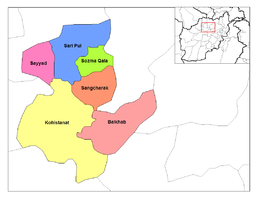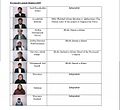- Sar-e Pol Province
-
Sar-e Pol (سرپل) Province Country Afghanistan Capital Sar-e Pol - coordinates 35°36′N 66°18′E / 35.6°N 66.3°E Area 16,360 km2 (6,317 sq mi) Population 505,400 (2009) [1] Timezone UTC+4:30 Main languages Dari Persian, Uzbek Sar-e Pol, also spelled Sari Pul (Persian: سرپل), is one of the thirty-four provinces of Afghanistan. It is in the north of the country. Sar-e-Pul Province is situated between the central highlands and the northern Turkmen plains. Sar-e-Pul borders Ghor and Baniyan provinces to the south, Faryab, Jawzjan and Balkh to the west and north, and Samangan to the east.[2] Its capital is the city of Sar-e Pol. Dari (Persian) is the dominant language in the province and in the region. The province was created in 1988, with the support of northern Afghan politician Sayed Nasim Mihanparast.[3]
Contents
Geography
Further information: Geography of AfghanistanIt is a mountainous province especially in its southern part. The province covers an area of 16,360 km. Three quarters (75%) of the province is mountainous or semi mountainous terrain while one-seventh (14%) of the area is made up of flat land. The province is divided into 7 Districts. The provincial capital is Sar-e Pol centre which has a population of about 115,463 inhabitants.[4]
History
Under the Taliban
Aminullah Amin, the first senior member of the Taliban to be captured, was the former governor of the province.[5][6]
Security
In 2009, Sar-e-Pul Police Chief, Muhammad Bilal Niram said arms had been collected from any people and three districts, namely, Sangcharak, Gosfandi and Sozama Qala areas termed as the peaceful districts of the province. In operations against the Taliban, the police chief said they had arrested a prominent Taliban commander Mullah Nadar along with 11 other people during the recent operations. He said scores of kilograms of hashish and opium had also been seized from people during the operations.[7][2] The biggest threat to travelers in Sar-i-Pul remains highway bandits and thieves, corrupt militiamen and police, and road hazards. The Taliban have small cadres operating throughout the province but rely on larger support networks in neighboring provinces.[2]
Politics and government
Further information: List of governors of Sar-e Pol and Politics of AfghanistanThe current governor of Sar-e Pol is Sayed Anwar Rahmati. Also Aziza Jalis, Sayed Anwar Sadat, Mohammad Hossein Fahimi, Sayed Mohammad Hossein Sharifi Balkhabi, Haji Khair Mohammad Imaq are the current Wolesi Jirga member of Sar-e Pol Province.[8]
Active political parties
Junbish-i-Milli Islami Afghanistan (National Islamic Movement of Afghanistan): General Abdul Rashid Dostum controls a political party called Junbish-i-Milli Islami Afghanistan (National Islamic Movement) which is a core of Jabhe-ye-Motahed-e-Milli. He claims to have a strong support in up to eight provinces in the north of the country, including Samangan province, predominantly populated by ethnic Uzbeks. Dostum's major power base is in Uzbek enclaves in the northern provinces of Jowzjan, Balkh, Faryab, and Samangan. Dostum's headquarters is located in Jowzjan’s capital, Sheberghan. In the past, Dostum held various official positions (deputy defense minister, a special adviser on security and military affairs, President Karzai's representative in the north) until the relations between President Karzai and General Dostum deteriorated.[2]
Jabhe-ye-Motahed-e-Milli (United National Front): The largest opposition block built by General Dostum and aimed against President Karzai. Burhanuddin Rabbani and the late Ahmad Shah Massoud's closest advisers joined Dostum in his demands to change the presidential system into parliamentary, to negotiate with armed groups and to recognize the Durand line. On August 27 of 2008 the Front in a statement urged the neighboring countries, members of the Organisation of the Islamic Conference, Russia, India, Saudi Arabia, and members of NATO alliance to hold a crisis meeting on Afghanistan.[2]
Hizb-e Wahdat-e Islami Afghanistan (Islamic Unity Party of Afghanistan): Hizb-e Wahdat-e Islami Afghanistan began as a Shi’a umbrella party led by Abdul Ali Mazari. Abdul Ali Mazari died under mysterious circumstances while in custody of the Taliban. During the Soviet invasion the party received support from Iran. The party "remains the primary political force among the Hazara." During the period of Taliban rule, the party held on to the Hazarajat against the attempted blockade by the Taliban. It is currently led by Mohammad Karim Khalili, who is currently the Second Vice President to Hamid Karzai. For a time Haji Mohammad Mohaqeq was the military leader of the party under the political leadership of Khalili. Mohaqeq and Khalili had a falling out, however, over Mohaqeq’s decision to run for president without the official approval of the party. Subsequently, Mohaqeq split away and formed his own party, Hezb-e Wahdat-e Eslami-ye Mardom-e Afghanistan. The original Wahdat party has begun to lose influence and support among the Hazara, in part because of the pull of Mohaqeq’s new party and likely because Khalili's position as Second Vice President distracts from his efforts to look after the needs of the Hazara.[2]
Jamiat-e Islami (Islamic Society of Afghanistan): Led by Burhanuddin Rabbani, Jamiat-e-Islami became the dominant political resistance party in northeastern Afghanistan. In 1980, Jamiat was the second most popular resistance front and enjoyed strong support from the Tajik communities of Badakshan, the Panjshir Valley and Herat Province in the west. Ahmad Shah Massoud, Ismail Khan, Mullah Naqibullah and Zabibullah, all influential Jamiat military commanders, would help galvanize Jamiat into one of the most formidable resistance movements of the Soviet-Afghan war. The failure of the Soviet Army to pacify the Panjshir Valley despite seven massive military offensives against the region between 1980 and 1984 solidified Ahmad Shah as a legendary commander and helped preserve popular support for Jamiat throughout the region. In general, Jamiat is considered to be a moderate Islamist movement that drew recruits from those educated in government schools (both religious and secular) and among the ulema (in the north) and the naqshbandi Sufi order found throughout the north. Although multiple ethnic groups including Pashtuns formed comprised Jamiat, it is most commonly referred to be dominated by Tajiks from the northeast.[2]
Supervisory Council of the North (SCN): In 1984, top resistance commanders operating the northern provinces of Takhar, Badakhshan, Balkh and Kunduz formed a council under the leadership of Ahmad Shah Massoud. The Supervisory Council of the North became an integrated military unit with both political and security components and posed the greatest threat to the communist occupation of Afghanistan in the north. Although many of the SCN leaders were affiliates of Rabbani’s Jamiat-e-Islami, the SCN established deep ties with local communities and ran its affairs independently from the Jamiat leadership based in Pakistan. Many former SCN commanders and fighters continue to exert influence and power at various levels throughout the Northern provinces.[2]
Hezb-e Islami Gulbuddin (HIG): Mujahideen party active since the Soviet invasion; led by Gulbuddin Hekmatyar. HIG was famous for its shifting loyalties, and was the favorite party of Pakistan’s ISI until the rise of the Taliban. Former members continue to wield considerable influence. Thus far, HIG has been actively opposed to US-led and Afghan national forces. Hekmatyar is a Kharoti Ghilzai and, therefore, less influential than the much more respected and powerful Khugianis, such as Haji Din Mohammad and Anwarul Haq Mohammad. Hezb-i-Islami in Sar-e Pol initially recruited Hazaras into their ranks until 1988 when many Hazaras switched allegiances to the Hezb-e-Whadat tanzim.[2]
Demography
Further information: Demography of AfghanistanSar-e Pol has a total population of 442,261. There are 73,266 households in the province and households on average have 7 members.[9]
Around three quarters (74%) of the population of Sar-e Pol lives in rural districts while one quarter (26%) lives in urban areas. Around 51% of the population is male and 49% is female. The major ethnic groups living in Sar-e Pol province are Uzbek, Pashtun, Hazara followed by Arab and Tajik, the major tribe is Uzbek in all districts. Persian is the most dominant language in the province. It is spoken by about 258,000 people (56%) and 525 villages (63%). The second most frequent language is Uzbeki, spoken in 149 villages representing 19% of the population.[9]
Sar-e-Pul province also has a population of Kuchis or nomads whose numbers vary in different seasons. In winter 59,843 individuals, or 2.5% of the overall Kuchi population, stay in Sar-e Pol. 57% of these are short-range partially migratory, 2% are long-range partially migratory and 40% is settled partially migratory. During both the winter time and the summer time they still migrate in search of good pastures within their respective summer and winter areas. The summer areas for the short range migratory Kuchi are in Sozma Qala, Sang Charak, Sar Pul, and Sayyad districts of Sar-e Pol province (in decreasing order of importance) and for the long range migratory Kuchi are in Chemtal and Sholgara districts of Balkh province. In summer some communities (around 184 households) migrate into Sar-e Pol province from Balkh. The Kuchi population in the summer is 60,292 individuals. Some 168 Kuchi households are also reported to live in IDP camps.[9]
Population by districts
The province is divided into 7 Districts.
Districts of Sar-e Pol Province District Capital Population Area[10] Notes Balkhab Tarkhoj 44,041[4] Gosfandi 39,721[4] Created in 2006 within Sayyad District; most recently created district up to date Kohistanat 72,037[4] Sangcharak Tukzar 87,670[4] 1,089 km2[11] Sar-e Pol Sar-e Pol 115,463[4] Sayyad 47,336[4] Sub-divided in 2006 Sozma Qala 36,993[4] Telecommunications
Further information: Telecommunications in AfghanistanBoth Roshan and AWCC are available to wireless subscribers in Sar-e Pol.[2]
Gallery
References
- ^ Central Statistics Office of Afghanistan. "Settled Population of country by Provinces and sex for 2006-2009 years". http://www.cso.gov.af/demography/population.html. Retrieved 2009-11-30.
- ^ a b c d e f g h i j Naval Postgraduate School, Program for Culture and Conflict Studies, Afghanistan, Sar-e Pol Province
- ^ Neamatollah Nojumi (2002). The rise of the Taliban in Afghanistan: mass mobilization, civil war, and the future of the region. Palgrave Macmillan. pp. 80–. ISBN 9780312295844. http://books.google.com/books?id=wR-4qmiOAvUC&pg=PA80. Retrieved 30 March 2011.
- ^ a b c d e f g h Afghanistan Provincial Development Plan, Provincial Profile of Sar-i-Pul, UNAMA
- ^ "Pakistan holds senior Taleban official". BBC News. 20 December 2001. http://news.bbc.co.uk/2/hi/south_asia/1721323.stm. Retrieved 2008-02-20.
- ^ "FINANCIAL SANCTIONS: AL-QAIDA AND TALIBAN -- AMENDMENTS MADE BY UN SANCTIONS COMMITTEE TO UN CONSOLIDATED LIST MAINTAINED UNDER RESOLUTION 1390 (2002) ON 18 JULY AND 27 JULY 2007" (PDF). Bank of England. August 3, 2007. http://www.bankofengland.co.uk/publications/financialsanctions/annex070803.pdf. Retrieved 2008-02-20.[dead link]
- ^ Zabeehullah Ihsas, "Armed groups a challenge in Sar-i-Pul", Pajhwok Afghan News, March 28, 2010
- ^ Independent Election Commission of Afghanistan, Afghanistan 2010 Wolesi Jirga Election Final Certified Results
- ^ a b c "B. Demography and Population". United Nations Assistance Mission in Afghanistan and Afghanistan Statistical Yearbook 2006, Central Statistics Office. Afghanistan's Ministry of Rural Rehabilitation and Development. http://www.mrrd-nabdp.org/Provincial%20Profiles/Sar-e-Pul%20PDP%20Provincial%20profile.pdf. Retrieved 2011-11-02.
- ^ Afghanistan Geographic & Thematic Layers
- ^ Ministry of Rural Rehabilitation and Development of Afghanistan, NABDP, Development Programme of Sangcharak District
External links
- Naval Postgraduate School, Program for Culture and Conflict Studies, Afghanistan, Sar-e Pol Province
- Afghanistan Research and Evaluation Unit (AREU), Afghanistan Livelihood Trajectories: Evidence from Sar-i-Pul
- Voice of Sangcharak

Jowzjan Province Balkh Province 
Faryab Province 
Samangan Province  Sar-e Pol Province
Sar-e Pol Province 

Ghor Province Bamyan Province Provinces of Afghanistan Badakhshan · Badghis · Baghlan · Balkh · Bamyan · Daykundi · Farah · Faryab · Ghazni · Ghor · Helmand · Herat · Jowzjan · Kabul · Kandahar · Kapisa · Khost · Kunar · Kunduz · Laghman · Logar · Nangarhar · Nimruz · Nuristan · Oruzgan · Paktia · Paktika · Panjshir · Parwan · Samangan · Sar-e Pol · Takhar · Wardak · Zabul
Categories:- Hazarajat
- Provinces of Afghanistan
- Sar-e Pol Province
- 1988 establishments
Wikimedia Foundation. 2010.


